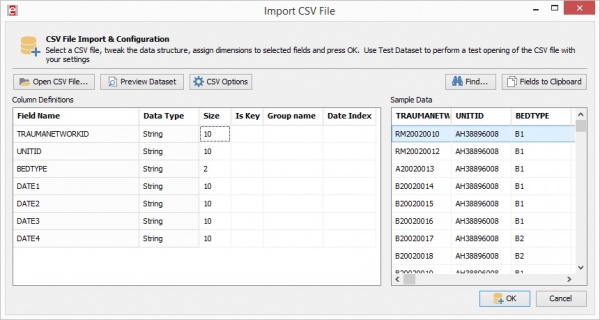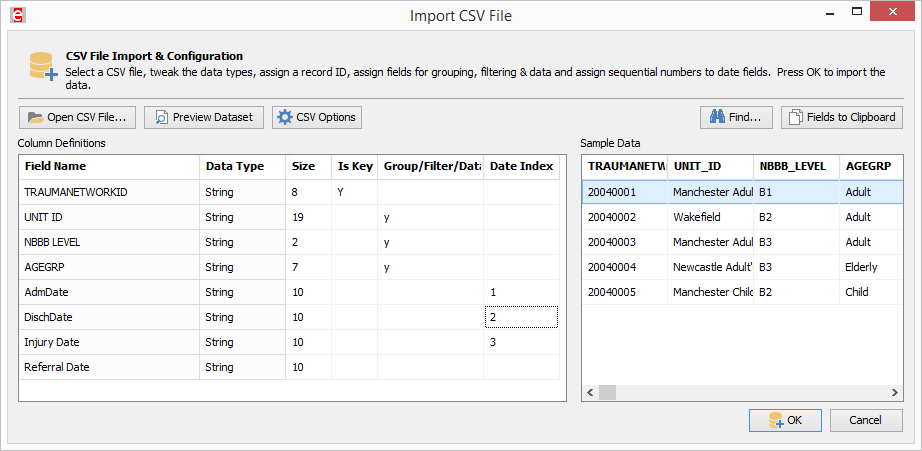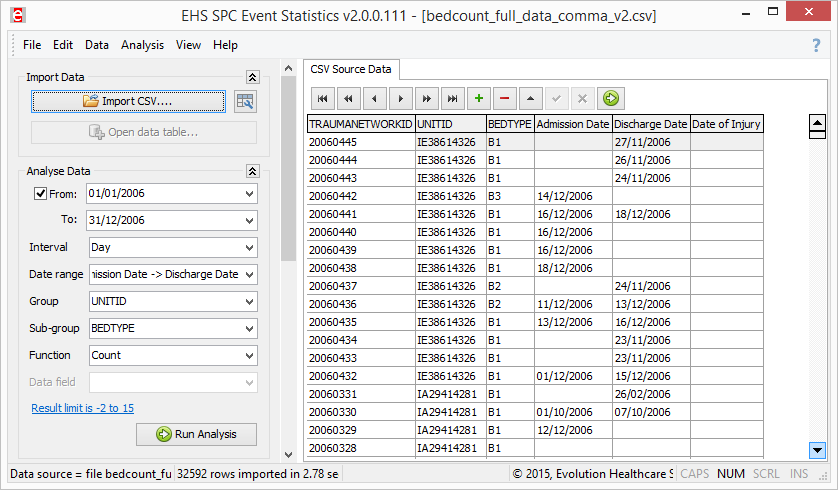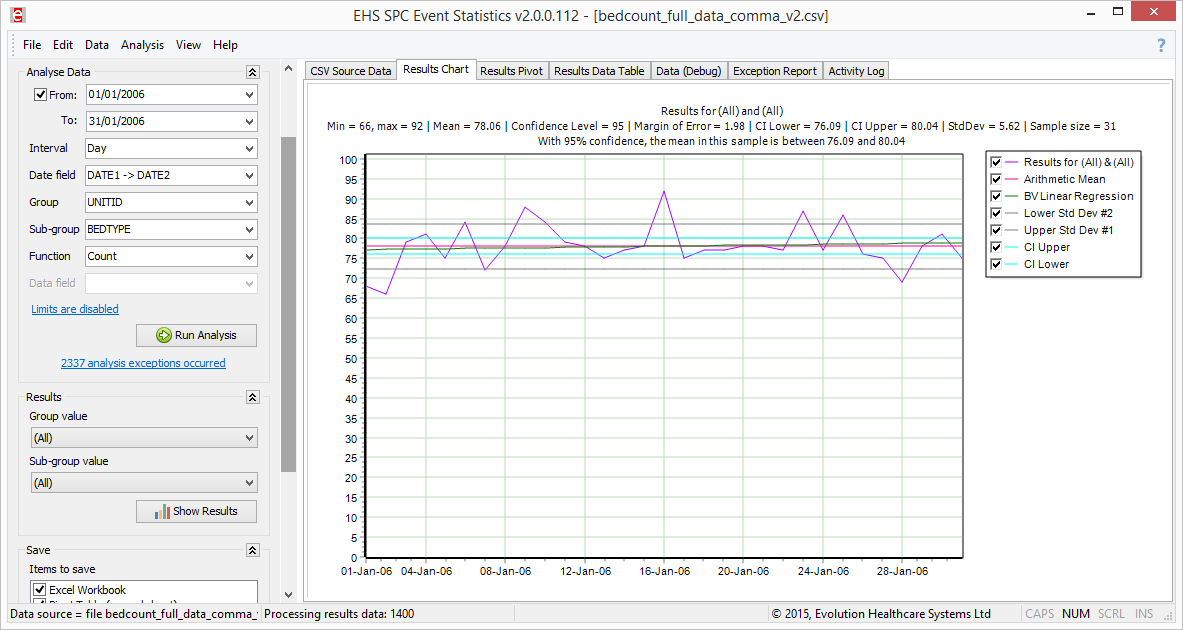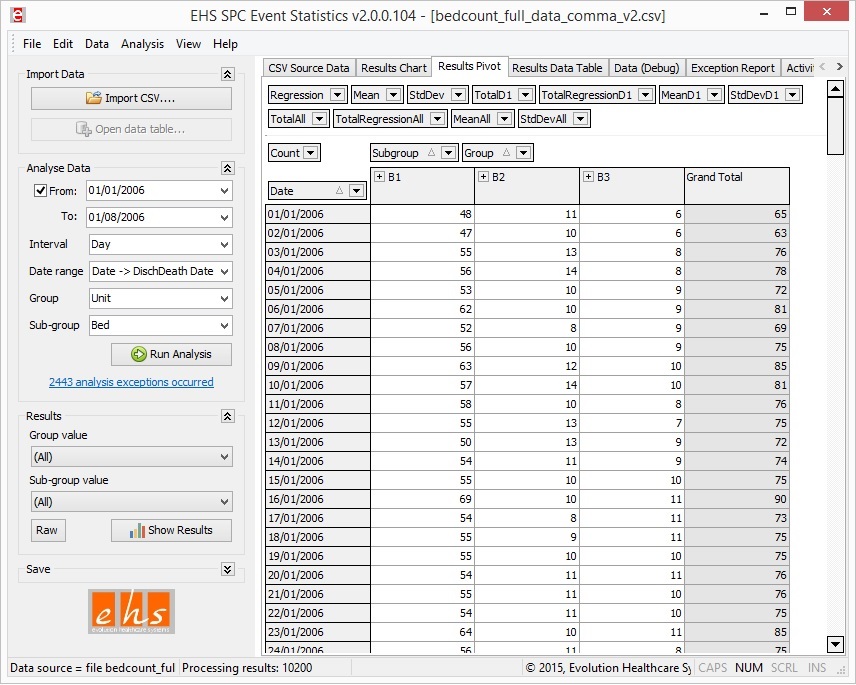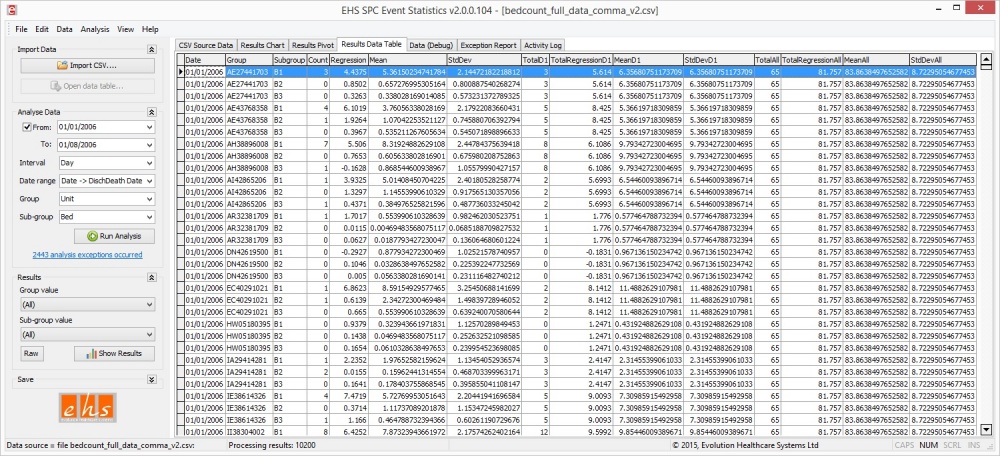Difference between revisions of "EventStats Quick Start"
(→Importing a CSV Data File) |
|||
| Line 11: | Line 11: | ||
Click the '''Open CSV File''' button and select your data file. EventStats will analyse the first 200 rows and present you with the column structure and a sample of the data file. ''Pay no attention to date fields interpreted as a string field, conversions will take place during the analysis'' | Click the '''Open CSV File''' button and select your data file. EventStats will analyse the first 200 rows and present you with the column structure and a sample of the data file. ''Pay no attention to date fields interpreted as a string field, conversions will take place during the analysis'' | ||
| − | [[File:Eventstats import CSV file before config columns.jpg]] | + | [[File:Eventstats import CSV file before config columns.jpg|Center|600px]] |
You must now modify the '''Column Definitions''' to tell EventStats where the data is: | You must now modify the '''Column Definitions''' to tell EventStats where the data is: | ||
| Line 41: | Line 41: | ||
Finally click the '''OK''' button to actually import the CSV file. | Finally click the '''OK''' button to actually import the CSV file. | ||
| − | |||
== Running Analysis == | == Running Analysis == | ||
Revision as of 10:16, 5 February 2015
A quick introduction to importing and analysing a CSV file in EventStats.
Contents
Importing a CSV Data File
Note: Source CSV files must have less than 256 columns
Click the Import CSV... button which opens the Import CSV File wizard
Click the Open CSV File button and select your data file. EventStats will analyse the first 200 rows and present you with the column structure and a sample of the data file. Pay no attention to date fields interpreted as a string field, conversions will take place during the analysis
You must now modify the Column Definitions to tell EventStats where the data is:
- Record Key: this is the field that uniquely defines every record in the data file.
- Enter a Y in the Is Key column on the appropriate row.
- There can only be one field marked as Record Key.
- Group Name: enter a name that will identify that this column is to be used for your analysis groups or for data filtering.
- Enter the name directly in the Group column
- You can specify as many groups as you want
- The name can be the same as the column name.
- You must use a different name for each Group column
- Enter a value here even if you only want to filter by that column
- Date index: enter a numerical value to identify this field as a date field in the Date index column.
- Odd numbers are start dates, even numbers are end dates.
- Pair dates together by using consecutive numbers, i.e. 1&2,3&4,5&6 and so on. e.g. If Admission Date is date index: 1, Discharge Date is then naturally date index 2.
- Multiple pairs of dates can be specified - you can choose which to analyse in the next step.
- To specify a single date field, just give it the next available odd number & do not allocate the even number to any field.
Only fields that have a group name, a date index or the key field will be imported
Example configuration:
In the above example, the Referral Date field will not be imported. You can click on the field name or data type values to open a window where you can change the field name, data type and all the other properties listed above.
Note also, that the CSV data is now editable. Records can be inserted, deleted and edited directly in the grid, and the CSV file can be saved using the Save CSV data and Save CSV data as... options in the file menu.
Finally click the OK button to actually import the CSV file.
Running Analysis
With the data file loaded, you can now filter your data, and specify your analysis parameters.
Filtering
- Use the column headers in the CSV Source Data grid to filter the source data. Only visible records will be included in the analysis.
- Use the Custom... option to specify more complex filters
- No need to filter date fields, this is done in the analysis section.
Analyse Data
- Select the From and To dates to analyse a limited range of records. This is highly recommended to prevent extensive processing times
- Pick your chosen interval from the list. Day is the most common choice.
- Choose the date fields to analyse in the Date range field. You will see the date fields you specified during the import process.
- Select the grouping and sub-grouping levels you require. You will be able to view results for all groups or by sub-group values within the group values. (More info in the results section)
Press Run Analysis to process the file and show the first set of results.
Always check the Exception Report to see which source records were excluded from the analysis. Some of the issues encountered in the exception report can be overcome by the analysis settings (more info needed)
Results
Results are presented as a chart, a customisable pivot table and a table of raw results. There is also an exception report and a limited activity log. Each is presented in their own tab.
Initially the total results for all groups and sub-group values are shown. You may like to drill down in to these results by changing the values in the Group and Sub-group fields on the left, and pressing the Show Results button.
You can show any of the following combinations:
- All sub-group values by all group values
- Specific sub-group value by all group values
- Specific sub-group value by a specific group value.
In order to drill down into a specific group value for all sub-group values, you will need to re-analyse the data by swapping the group and sub-group field names and pressing Analyse again. That way the grouping is reversed and you can drill down again.
Results Chart
As the screen shot above shows, the chart contains the results line and also the bivariate regression (best fit) line, the mean, sample standard deviation and margin of error data.
The various data series can be toggled via the checkboxes on the chart legend.
The chart can be zoomed by dragging a rectangle from top-left to bottom-right anywhere on the chart. Zoom out by drawing a rectangle from bottom-left back to top-right.
Results Pivot
The pivot table is initially set up for you, but can be customised according to your needs.
You can alter the pivot table by moving fields around to the various sections in the table: data, row, column and filter.
The group and sub-group values are combined to make the column values. The group only is used if there is no sub-group value.
Results Data Table
This data table is provided for reference purposes and is saved as an Excel spreadsheet (see later for Saving options).
The data contains the following columns:
- Date: the event date-point. There is one date per unique group & sub-group value.
- Group: a distinct value from the field selected as the group field in the analysis.
- Subgroup: a distinct value from the field selected as the sub-group field in the analysis.
- Count: number of records in the CSV data file for that date, group and sub-group combination.
- Regression: the actual value of the best fit line - again per date, group and sub-group combination.
- Mean & StdDev: the mean & sample standard deviation, per date, group and sub-group combination.
- TotalD1: number of records in the CSV data file for that date and group combination. This count field excludes the subgroup field.
- TotalRegressionD1, MeanD1', StdDevD1: Best fit, mean & sample std dev values per date & group value (excluding the subgroup field)
- TotalAll: number of records in the CSV data file for that date. Excludes any grouping. This field is the total of all records for that date.
- TotalRegressionAll, MeanAll, StdDevAll: best fit, mean and sample std dev values for all records for that date. Excludes any grouping.
Notes
- All fields ending in ...D1 or ending in ...All will have repeating values, as they are calculated without various grouping levels. In order to view these fields correctly, you should filter the data table by a single group value and a single sub-group value. The actual value of the group and sub-group values does not matter where the All fields are concerned, and for the D1 fields, you should specify the group value you are interested in, and choose any sub-group value.
Saving Results
Result are saved as separate files inside a selected folder. The current grouping values in the Results section are used as sub-folders to prevent overwriting of files when saving multiple times.
The saving of each file type is optional:
- the current chart image as a JPG
- an Excel worksheet representing the raw results data
- the same raw data as a proprietary data file
- an Excel worksheet which is a copy of the pivot table (not an actual pivot table)
- the original CSV source data
- the Exception report as an Excel worksheet.
In the Save section, tick the boxes next to each item to save, and press the Save Results button. You will be asked to select a folder into which the results files will be saved.
If you have changed the grouping values in the Results section since the last time the results were saved and you press Save Results - the results are updated prior to the save to ensure your results are saved as you expect them. This is a relatively quick way of saving lots of results. Just change the group/sub-group values, press save results & repeat.
